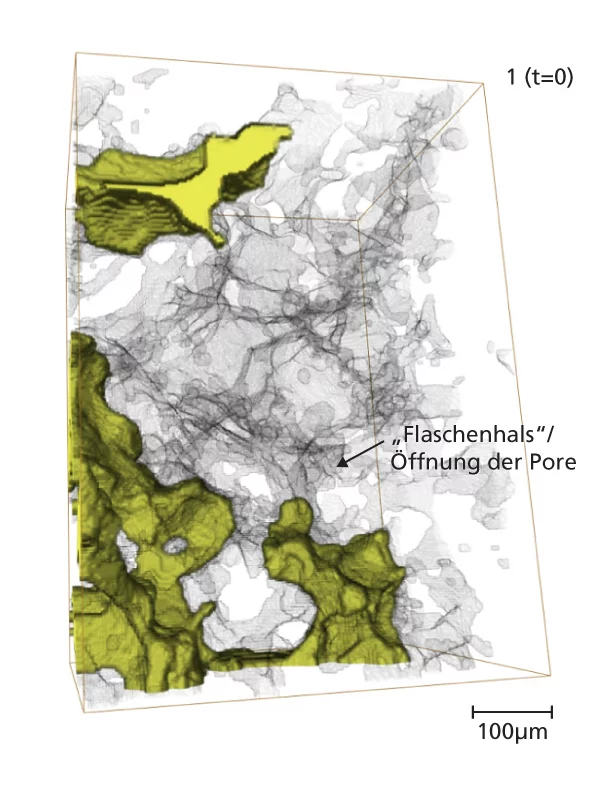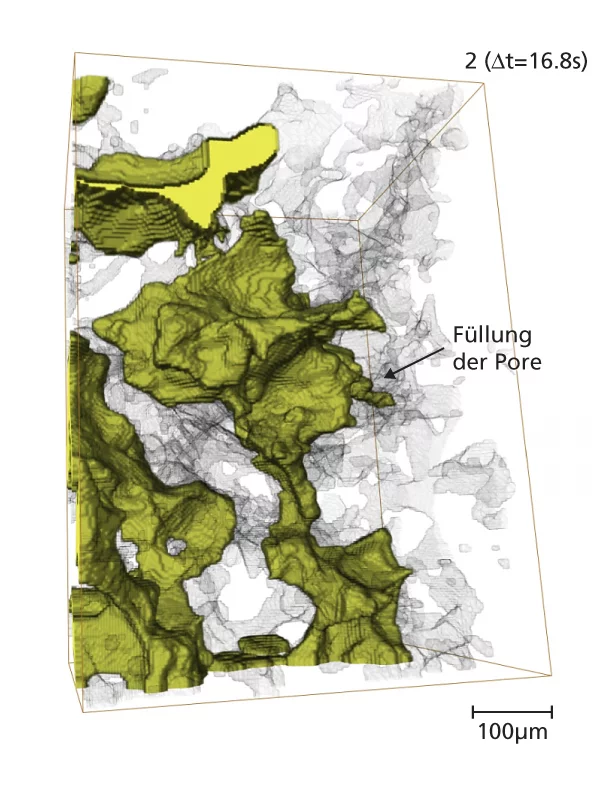For the first time, experiments using computed tomography have allowed scientists to observe in 3D the flow of oil and water in real rock on an unprecedented scale. The new approach trailed and the information gathered by the experiments contribute to an improved understanding of multiphase flow and transport in porous media. The research was performed by a joint team of scientists from Shell, the Paul Scherrer Institute in Switzerland and the Johannes Gutenberg University in Germany. The results have been published in the Proceedings of the National Academy of Sciences.
On a global scale conventional oil production leaves approximately 50-70% of the oil behind. With this new insight into the fundamental processes the industry can develop new and safe methods to produce more oil from existing reservoirs. Oil and gas are typically trapped inside small pores in sedimentary rocks. Standard approaches for describing macroscopic behaviour of simultaneous flow of several immiscible fluids, such as oil and water have many shortcomings and do not contribute to our understanding of the processes on the level of single pores. The new experimental data provide a ground-breaking reference to validate pore-scale numerical models with individual pores at a spatial resolution of a few thousandths of millimetres. The experiments have been performed at the Swiss Light Source at the Paul Scherrer Institute and are based on a new fast computed tomography (CT) technique for 3D visualisation of the processes as they happen. In these experiments small samples of the rock are illuminated from different directions with high intensity X-rays, and the images produced are combined to provide high resolution 3D images that can be put together to create a movie showing the processes.
Sarah Irvine, the supporting scientist at the Paul Scherrer Institute, who helped develop the fast tomography technique and execute the experiment, said: “In the past, full CT scans at this spatial resolution would have taken 20 minutes or longer. Using X-rays from the SLS with our fast tomography setup, we can acquire individual projection images in a few milliseconds or less. Typically over a thousand of these acquired over 180° of rotation are combined to reconstruct a full 3D data set with a total scan time of just a few seconds, or even faster”.
Michael Kersten of the Institute of Geosciences at Johannes Gutenberg University in Mainz, Germany, said: “This achievement is important to understand how a mixture of several fluids flows through pores of different sizes”. The Mainz researchers contributed primarily to the data analysis and visualisation. Thanks to their software skills and experience gained over a decade of CT work, Kersten’s group was able to reduce over 10 TB of high-resolution data down to minute-lasting movies of the key events. The results shed light onto characteristics of fluid-behaviour that up till now were only poorly understood. For the first time ever, the researchers were able to directly observe so-called Haines jumps, sudden changes in the way a fluid moves through porous media, in actual rock. The findings oppose the common paradigm that such changes are locally restricted to single pores. Instead, they cascade through dozens of pores simultaneously.
Steffen Berg, research institute member of Shell Global Solutions International B.V. at Rijswijk, The Netherlands, said: “This work has the potential to change how we look at the mechanisms in porous media and apply this improved understanding to solve some of the energy industry’s greatest challenges. The new quantitative data helps to build and validate computer models used to describe the flow of fluids in porous rock. It enables us to ultimately predict macroscopic behaviour and to optimise enhanced oil recovery techniques accordingly”.
About PSI
The Paul Scherrer Institute develops, builds and operates large, complex research facilities, and makes them available to the national and international research community. The Institute's own key research priorities are in the investigation of matter and material, energy and the environment; and human health. PSI is Switzerland's largest research institution, with 1500 members of staff and an annual budget of approximately 300 million CHF.About the Institute for Geosciences, Johannes Gutenberg University
Located on campus of the Johannes Gutenberg University Mainz, the Institute of Geosciences is part of the Earth System Science Research Center 'Geocycles' of Rhineland Palatinate. The institute consists of fourteen working groups, spanning a wide range of research topics from geophysics to petrology and paleoclimate studies to environmental mineralogy. With its renowned expertise in instrumental analytics, Geocycles and other major cooperation partners close by, the institute offers a highly diverse education in geosciences and facilitates innovative interdisciplinary research.About Royal Dutch Shell plc
Royal Dutch Shell plc is incorporated in England and Wales, has its headquarters in The Hague and is listed on the London, Amsterdam and New York stock exchanges. Shell companies have operations in more than 80 countries and territories with businesses including oil and gas exploration and production; production and marketing of liquefied natural gas and gas to liquids; manufacturing, marketing and shipping of oil products and chemicals and renewable energy projects. For further information, visit www.shell.com.Contact
Dr. Sarah Irvine, Laboratory for Macromolecules und BioimagingPaul Scherrer Institute, 5232 Villigen PSI, Switzerland,
Phone: +41 56 310 5422; E-mail: sarah.irvine@psi.ch
http://www.psi.ch/sls/tomcat/tomcat
Prof. Dr.-Ing. Michael Kersten, Head Environmental Mineralogy
Institute for Geosciences, Johannes Gutenberg University Mainz
55128 Mainz, Germany Phone: +49 (0)6131-39-24366; E-mail: michael.kersten@uni-mainz.de
http://www.geowiss.uni-mainz.de/583_ENG_HTML.php
Dr. Steffen Berg, Shell Global Solutions International B.V.
2288 GS Rijswijk, Niederlande
Tel.: +31 70 447 6161, E-Mail: steffen.berg@shell.com
www.shell.com
Original publication
Real-time 3D imaging of Haines jumps in porous media flowSteffen Berg, Holger Ott, Stephan A. Klapp, Alex Schwing, Rob Neiteler, Niels Brussee, Axel Makurat, Leon Leu, Frieder Enzmann, Jens-Oliver Schwarz, Michael Kersten, Sarah Irvine, and Marco Stampanoni
Proceedings of the National Academy of Sciences
Published online before print February 19, 2013, DOI: 10.1073/pnas.1221373110


